This is a Canon IV Sb 35mm rangefinder camera, produced by the Canon Camera Corporation of Tokyo, Japan starting in December 1952. The IV Sb was the world’s first 35mm camera to support flash sync for both flash bulbs and electronic X-sync through Canon’s proprietary rail mounted flash shoe. It used the M39 Leica Thread Mount and had a body design heavily inspired by the Leica III rangefinder, but with several significant improvements. The IV Sb was produced for two years, eventually replaced by the IV Sb2 and is considered by many collectors to be one of Canon’s finest screw mount 35mm rangefinder cameras.
Film Type: 135 (35mm)
Lens: 35mm f/3.5 Canon Serenar coated 4-elements, 50mm f/1.9 Canon Serenar coated 6-elements
Lens Mount: M39 Leica Thread Mount
Focus: Rangefinder limited 3.5 feet to Infinity
Viewfinder: Coincident Image Coupled Rangefinder with Rotating Variable Viewfinder Prism
Shutter: Cloth Focal Plane
Speeds: T, B, 1 – 1/1000 seconds
Exposure Meter: None
Battery: None
Flash Mount: Canon Flashgun Rail Mount w/ FP and X Flash Sync @ 1/15 second
Weight: 692 grams (w/ VF and lens), 660 grams (w/ lens only), 510 grams (body only)
Manual: http://www.cameramanuals.org/canon_pdf/canon_ii_d_iv_s2.pdf
How these ratings work |
The Canon IV Sb was named by Canon rangefinder historian Peter Dechert as Canon’s second most important camera in it’s journey toward being a dominant force in the optics industry. The IV Sb was Canon’s first successful camera to be sold in the United States, and offers features that the Leica II and III of which it was based on, didn’t. On top of that, it had a build quality that matched, and in some cases exceeded that of the German camera. Like all Barnack Leicas, it is compact and easy to shoot, and with the Serenar 35mm lens and auxiliary viewfinder is an absolute pleasure to shoot. All Barnack Leicas deserve their place in any collection, but if you cannot afford the real thing, you could do a lot worse than the IV Sb. | ||||||
| Images | Handling | Features | Viewfinder | Feel & Beauty | History | Age | |
| 2 | 2 | 1 | 2 | 2 | 2 | 30% | |
| Bonus | +1 for overall perfection, the complete package | ||||||
| Final Score | 15.3 | ||||||
History
 The Canon IV Sb was first released in December 1952 and was produced until March 1955. Behind the Canon IIB, it was Canon’s second most significant camera at the time as it made a huge impact on overseas markets who hadn’t yet heard of Canon, or weren’t yet willing to take a chance on a Japanese made camera.
The Canon IV Sb was first released in December 1952 and was produced until March 1955. Behind the Canon IIB, it was Canon’s second most significant camera at the time as it made a huge impact on overseas markets who hadn’t yet heard of Canon, or weren’t yet willing to take a chance on a Japanese made camera.
As they did with most of their early rangefinders, Canon did not identify the actual model of the camera anywhere on it, rather referring them to their factory designations. The IV Sb was an internal name for the camera, but it was commonly sold as the IV S2, even using that name on the camera’s US user’s manual. In some cases, the camera was simply sold as the Canon 35 as it was the first Canon camera sold in many markets.

The IV Sb was essentially an IV S with only two modifications, the first was a lock on the slow shutter speed knob, keeping it in the 25 position when the slow speeds were not in use. The second, and much more significant change was an X-sync mode which allowed for the first time ever, the camera to synchronize for electronic, or X-sync flash bulbs. The letter “X” appeared on the camera’s front mounted slow shutter speed dial between 8 and 25, giving an X-sync speed of about 1/15 of a second which was the fastest speed the shutter curtains could stay open and complete the flash cycle before the second curtain would begin closing. The simplicity of the IV Sb’s X-sync feature was later offered as a dealer modification to IV, IV F, and IV S cameras for those interested in the feature.
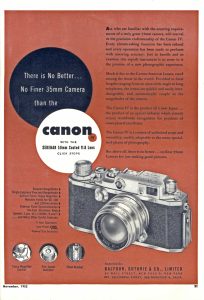
The inclusion of this new X-sync feature, which was common on leaf shutter cameras of the time, but not focal plane shutters like the IV Sb, along with Canon’s rotating variable focal length viewfinder were seen as major upgrades to the Leica II and IIIs that the IV Sb was based on. Although Canon’s acceptance was slow at first, professional photographers began to switch from their German Leicas to Canon.
The Canon IV Sb was sold in the United States exclusively through distributors such as C.R. Skinner in San Francisco and Balfour, Guthrie & Co., in New York City, rather than from Canon directly. In an effort to increase interest in a previously unknown brand of cameras, the Canon IV Sb came with a 5 year guarantee. The camera sold with the new Canon 50mm f/1.8 lens for $295.00 or with the 50mm f/3.5 for $250.50. These prices when adjusted for inflation compare to $2850 and $2425 today, quite a high price for a brand entering a new market for the first time.
Canon made a major push in the US market trying to promote their cameras as a viable alternative to the German rangefinders that were preferred by professional photographers. They took out many ads in major US photographic magazines trying to convince photographers to give them a shot. Here is a gallery of 14 different ads that I found all for the Canon IV S2 (the US name for the IV Sb).
With the release of the IV Sb, another change happened at Canon, which was the discontinuation of the Serenar line of lenses. Starting in late 1952, all new Canon lenses would be simply identified as Canon lenses, but due to a large supply of Serenar lenses, many early IV Sbs sold with Serenar lenses until supply ran out.
Most Canon rangefinders were exported to the United States and Europe, but for many people the IV Sb was the first model that was a serious contender for the professional photographer’s dollar. In total, 34,975 were produced, making it the third best selling Canon rangefinder, behind the P and the 7.
Canon’s new rangefinders were warmly received by the US photographic press. In November 1952, an in depth look by Modern Photography magazine gave US photographers their first look at a Canon rangefinder. For readers today, it might seem odd to think of Canon as an unknown company, but in the first paragraph, author John Wolbarst helps set the stage for those first reading this back in 1952.
If you have ever heard of the Canon camera, except in an advertisement, you are in a minority among American photographers. If you have ever seen one, you can put yourself in an even smaller group. Should you happen to have bought a Canon more than three months ago, you are probably either a member of the Armed Forces…or an extraordinarily astute (or reckless) camera buyer.
In July 1954, while the IV Sb was still in production, Canon would release an updated model called the IV Sb2. Although a simple change to the name, the new model had a completely new shutter that had internal improvements to Canon’s early focal plane shutters which were heavily inspired by the original Leica shutters.
The new shutter was timed using the modern arithmetic scale with speeds of 15, 30, 60, and 125, instead of the earlier scale of 20, 40, 50, and 100. It also was Canon’s first focal plane shutter where the fast speeds could be set with the shutter wound or unwound, a major improvement from the original. The new shutter also supported a much faster 1/45 second X-sync which helped eliminate ghosting when using an electronic flash with the earlier model’s slow 1/15 X-sync speed. Strangely, a second X mark appears on the slow dial between 15 and 30 to maintain backwards compatibility with early electronic flashes with built in delay circuits.
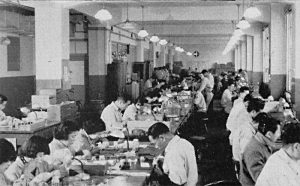
The IV Sb2 also featured an improved viewfinder with a slightly larger rear eye piece. The size increase was not significant, and most people likely wouldn’t even notice it unless you had an IV Sb and IV Sb2 side by side, but it is there. With these improvements, Canon rangefinder historian Peter Dechert declares the IV Sb2 as the finest bottom loading 35mm camera ever made.
In 1954, the Ernst Leitz company would release the Leica M3, a revolutionary new camera that completely turned the 35mm rangefinder market upside down. The new M3 was far and above superior to the companies early Leica II and IIIs in nearly every way that was important. When the M3 was released, it took the entirely of the Japanese camera market by surprise. Neither Canon, nor Nippon Kogaku (Nikon) had anything even remotely close planned.
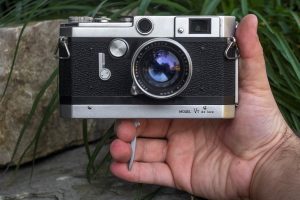
Canon was quick to realize they would need to come up with something new to help minimize the perceived gap in superiority between the new Leica and their best model. In 1955, work began on a new Series V Canon rangefinder which would retain the familiar M39 screw mount, but would have a completely redesigned top plate with a larger viewfinder, a bottom mounted trigger film advance system, a new PC flash port in place of the side rail, and a hinged rear door. Although significant upgrades, internally, the new camera was nearly identical to that of the IV Sb2.
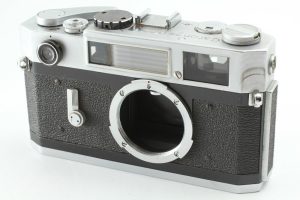
The new Series V would eventually go on sale in April 1956 as the Canon VT and itself would launch a new series of Canon screw mount rangefinders that would eventually culminate with the Canon 7sZ from 1967-68. Canon would never release a direct competitor to the Leica M3 or any interchangeable 35mm rangefinder camera without the M39 screw mount.
Starting in 1959, Canon would split their efforts between their new SLR, called the Canonflex and their consumer grade fixed lens rangefinders. For reasons far beyond the scope of this article, Canon was unable to compete with Nippon Kogaku in the 35mm SLR market, at least not for another couple of decades.
Today, Canon screw mount rangefinders aren’t quite the secret they once were in the early 1950s. As we all know today, Canon would continue to grow, perfecting their technology, and eventually becoming one of the most important and trusted optics companies in the world. To this very day, their DSLRs are sought after by professional photographers and their recently released EOS R line of digital mirrorless cameras are highly regarded.
Screw mount Canon’s are often suggested as cost effective alternatives to German Leicas, and for some, are considered superior. Later models such as the P and 7-series seem to be the most commonly recommended, but the IV Sb being reviewed here is deserving of just as much praise. These were classically designed cameras with incredible build quality, and a feature set that was state of the art at the time they were released, certainly worthy of addition to any collection.
My Thoughts
Everyone wants a Leica…or so I thought. Why wouldn’t you? Arguably one of the most successful and storied camera brands in the history of photography, the camera world was never the same after Oskar Barnack‘s creation first went on sale in the mid 1920s. Fun fact, the original Leica was created as a single exposure film tester while Barnack was working on a motion picture camera. His early prototype sat on a shelf for nearly a decade before a weakened German economy forced Leitz to consider re-purposing it for still photography.
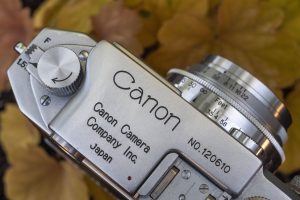
But this isn’t a history lesson about German cameras, it’s a review of the Canon IV Sb a camera that is two cameras in one. At a glance, the Canon looks like a near identical copy of a Barnack Leica III. From 10 feet away, most casual observers wouldn’t even be able to tell the difference between the two. Once you get to handle the camera and really inspect it, you see that the Canon IV Sb is a heavily improved version of the Leica III featuring things like a variable focus viewfinder and flash rail with electronic synchronization, that no screw mount Leica ever had.
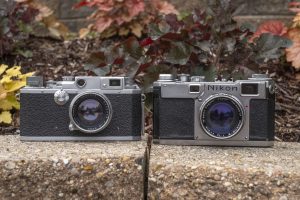
There is no denying that Nippon Kogaku introduced the world to Japanese camera lenses, but it was Canon’s rangefinder cameras that proved that the Japanese could make things beyond lenses. Canon historian Stephen Dechert considers the Canon IV Sb not only one of the Canon’s most important cameras, but also one of the most important Japanese cameras of all time.
Why is that exactly? Well, for one, Canon’s dedication to quality control was second to none. By the 1950s, the world started to learn that the Japanese took quality control very seriously. Cameras were built with the highest attention to detail and were inspected multiple times, as often as possible, ensuring that no defects ever left the factory.
I had handled a few Leicas prior to owning this Canon and thought they were fine machines. I completely understood why people liked them. Barnack Leicas are actually quite a bit more compact than I had realized before handling my first one. These were purpose built machines designed to make photos, and that’s what they did for a quarter of a century before any serious contenders hit the market.

Everyone copied them, the Japanese, Soviets, Italians, the Brits, and even American companies all made their versions of the Leica II and IIIs but for many, it was Canon’s copies that both maintained the quality of the original, along with adding some improvements to the camera to make them more usable so when I had a chance to pick up this IV Sb body in fantastic condition, I knew I had to have a lens. I could have been content to mount my Nikkor 50/2 lens that was very popular when this camera was built, or any number of Soviet M39 lenses I have, but I wanted an all Canon experience, and since I have a fondness for wide angle, I went with this nice 35mm Serenar f/3.5 with Canon 35mm viewfinder.
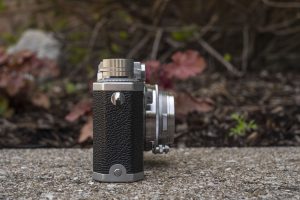
The 35mm Serenar is an extremely narrow lens from front to back. If you didn’t know any better, you’d think this was a collapsible lens, and if I’m being perfectly honest, the first time I handled it, I tugged on it as I wasn’t sure either. Thankfully, no tugging is needed as the lens performs how it should exactly as you see it in the images here. This gives the Canon a compactness that makes it slide into medium coat pockets or small hand bags with ease. The clip on 35mm viewfinder somewhat negates the compactness of the camera, but it’s extremely large and bright view definitely makes up for it.
The camera as a whole feels solid, but not heavy. The body has slightly angled edges instead of rounded curves like other Barnack Leicas, which was thought to make the camera more rigid. Weighing in at a total 692 grams with the lens and viewfinder, the Canon IV Sb is a camera I would feel comfortable hanging around my neck all day long.

If you’ve ever shot any Barnack style Leica II or III copy (or the real thing), the top plate of the camera should look familiar with only a couple differences. Starting on the left, we have the pop up rewind knob, with a viewfinder magnification lever beneath, which I’ll get to later in this review. In the center is the accessory shoe for mounting accessories such as the 35mm viewfinder that comes with the Serenar lens. The 35mm viewfinder has manual parallax correction which tilts the viewfinder down for closeups.
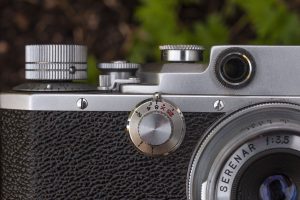
Next to the show is the single piece shutter dial for speeds 1/25 and faster. The single piece shutter speed dial on the IV Sb rotates as the shutter fires, so care must be used to not touch it while firing the shutter, or else you will throw off it’s speeds. For speeds slower than 1/25, you must have it set to the position marked 25-1, which then activates the slow shutter speed dial on the front of the camera for speeds down to 1 second. This is also where the camera’s 1/15 X-sync speed is selected.
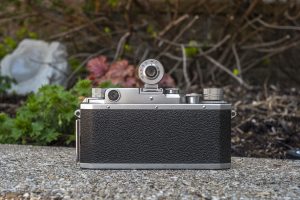
The back of the Canon doesn’t have much to see. Film is loaded through the bottom of the camera, so the back does not come off, nor is there any window to see into the film compartment like the Nicca 5L/Tower 45/46 cameras.
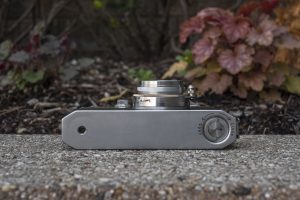
The bottom of the camera has a Leica style lock on one side and a 1/4″ tripod socket on the other. Like all other bottom loading Leicas, the tripod socket is built into the bottom plate and not the main body of the camera, which is a weaker connection to the tripod. If the camera were to take a fall or you were to mount a heavy lens to the camera while mounted to this socket, the bottom plate can become distorted, or in extreme instances, break off. To combat this, Canon offered a novel “camera holder” accessory which mounted to the bottom of the camera and cradled it, while offering a much stronger tripod mount for heavy lenses.
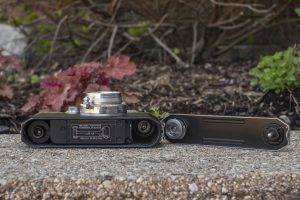
Loading film into the Canon IV Sb is exactly the same as every other bottom loading Leica or Leica copy, which means you need to trim the leader of a new roll of film to approximately 10 centimeters before installing it into the camera. Some people claim to be able to load 35mm film into these cameras without trimming it, but it’s not something I would recommend trying. There are also cutters that you can buy online that make a perfect cut to the right length, but simply, using a pair of scissors and extending the leader the width between the two spools is all I ever do and it works fine.
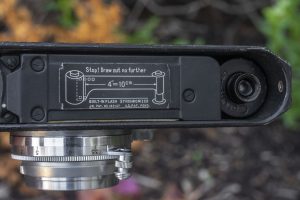
For more information showing exactly how this is done, I typed up instructions in my review for the Leica Ic, but a simple Google search will return many dozens of results as well.
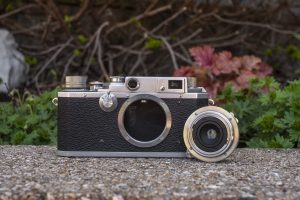
Of all the ways the Canon IV Sb is different from the Leica III it is based on, one area in which it is exactly the same is in it’s lens mount. Using the M39 Leica Thread Mount, all Canon lenses are compatible with those designed for the Leica. Canon not only copied the mount, but wisely used a similar wheeled rangefinder cam with is not only smoother, but more dependable than the curved metal arm of Soviet Leica copies such as the Zorki and FED.
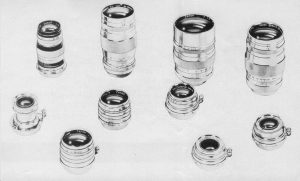
Canon’s lenses were top notch as well. Early Serenar lenses performed at least as well as their Leitz counterparts, but Canon was an up and coming company and continue to improve their designs with each new lens. The earlier collapsible Serenar 50mm f/1.9 was replaced with a non-collapsible 50mm f/1.8 “kit” lens typically offered with this camera, but they had at least 12 other lenses to choose from, ranging from a 28mm f/3.5 all the way to a monster 800mm f/8 mirror reflex lens. Canon’s standard lenses were generally quite good, comparing favorably to those made by other manufacturers like Nippon Kogaku and Carl Zeiss.
Where the Canon IV Sb was the most innovative was in it’s viewfinder. Using a combined coincident image rangefinder patch was already an update to the dual viewfinder/rangefinder setup of the Leica II and III series, but Canon implemented a clever rotating prism in the viewfinder that could increase magnification by 1x and 1.5x from the standard 50mm field of view.
This proved to be very useful in two ways. First, with the viewfinder set to the 1x position, it showed an effective field of view matching a 100mm lens and at 1.5x, a 135mm lens. This means that when using such lenses, an auxiliary viewfinder was not necessary. But it was still useful when using lenses shorter than 100mm such as the 50mm or 35mm ones because by moving the viewfinder to the 1x or 1.5x position, the entire viewfinder image, including the rangefinder patch was magnified, allowing for a more precise view of the split image. With the viewfinder at the 1.5x position, the circular rangefinder patch takes up almost the entire view, essentially giving you one huge double image. The position of the magnification lever on the left side of the top plate is in easy reach of the photographer’s left hand meaning you can seamlessly toggle between the 50mm view and the 1.5x view and back, without ever having to lower the camera from your eye.
Note: I captured the above images using my smartphone’s camera, and due to difficulties in capturing an image through the Canon’s viewfinder, the 1x and 1.5x images look darker than they are in person. Although the edges are darker than the “F” position, it’s not as bad as it appears in these images.
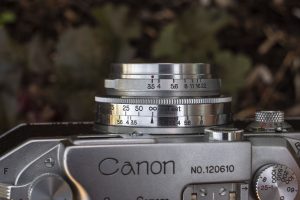
For me, with the 35mm auxiliary viewfinder attached, I just left the viewfinder in the 1.5x position for a quick glance at the rangefinder for focusing and then I’d move my eye to the very large and bright auxiliary viewfinder for composition. Despite having to look through two different viewfinders, I found this approach to be very easy, as the wide depth of field of the 35mm lens meant that precise focus wasn’t even necessary at most distances.
It’s probably a bit redundant for me to say this, nearly 70 years after this camera was constructed, but I absolutely believe Canon’s early screw mount rangefinders to be every bit as good as their German counter parts. Add in the very useful rotating viewfinder, an excellent selection of Canon lenses, and X-sync, and the Canon IV Sb is one of my all time favorite cameras. It’s compact, easy to carry, easy to focus, and makes great images. Oh wait, I haven’t shown you the images yet. Keep reading…
My Results
I first shot the Canon IV Sb in the fall of 2018 using Fuji 200 color film which is my go to film for cameras I have no experience with. It has a decent amount of latitude, accurate (if a bit muted) colors, and is cheap. Although I had detected a tiny amount of haze within the 35mm Serenar lens, I didn’t think it would show up in the images.
I was wrong. After seeing the results, many of the images were low in contrast and ones showing the sky or indirect sunlight were very washed out. The color images in the gallery below are from that roll.
I was in love with the lens however, and not wanting to finish this review until I had another change to shoot it, I searched for a second Serenar lens, which I found in late spring of this year. Sadly, this lens too, had some haze, but it wasn’t as thick as the first one. To help combat the haze, I decided to try black and white which has a better ability to show contrast through haze, plus it’s easier to correct in post. The black and white images below are from that roll of bulk TMax 100 developed in HC-110 Dilution B.
My experience with the 35mm Serenars was a bit of a let down due to the haze, but after talking with other collectors and observing other examples of this lens, it seems that whatever materials Canon used when building these lenses has caused haze to be a common symptom today.
With that out of the way though, I still think I got some pretty good images from the camera. The compactness of the Barnack body combined with the very compact lens, makes for an excellent shooting companion. In the right circumstances, the haze can even give the images a dreamy look that some people would say enhances the image. I am not a good enough photographer to anticipate an image beforehand that would benefit from this look, but on occasion I do have “happy accidents”.
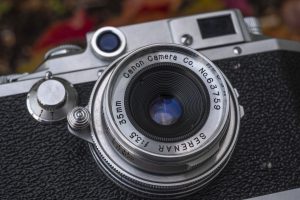
This being a website in which I talk about old cameras, minor issues like this are a reality that I deal with often. The good news is that I can look past them and declare the Canon IV Sb a winner. I was so happy with this camera, I never bothered to mount the 50mm f/1.9 Serenar or any other Leica Thread Mount lens that I had to it. Maybe one day I will shoot this camera with one of those lenses, but it’s unlikely to change my opinion of it.
Is the Canon IV Sb perfect? I guess that depends on your definition of perfect. Would I have preferred a film advance lever instead of a knob, a larger viewfinder/rangefinder window, or a rear door for loading film? Yeah, I would, but I’d argue that the lack of those features doesn’t actually make the camera bad.
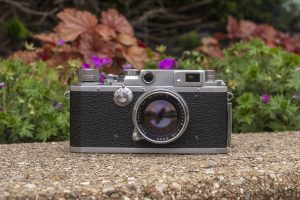
In fact, the lack of those features makes for a more enjoyable experience. This is an old camera with a design from days of yore. Would I expect an early microcomputer to work like a modern PC today, or a Ford Model T to have the same controls as a brand new car? Of course not. The Canon is no different. Sometimes, even less is more, and in the case of the Canon IV Sb, this camera definitely has a lot more!
I’ve still yet to shoot a Leica II or III that this camera most closely resembles, but I can wholeheartedly say that the IV Sb makes that desire almost non existent. Canon’s excellent build quality, adjustable focal length viewfinder, and innovative X-sync make this better than any Barnack Leica out there…and for a fraction of the price.
When writing this review, I was shocked to find so little information on the web about it. Camerapedia and Camera-Wiki are two sites that often have a great deal of information about many cameras, but both sites have the exact same combined Canon II/III/IV article that don’t even mention the IV Sb. I scoured Google looking for blog reviews or articles about this camera and again, came up with very little. After 200+ reviews on this site, I’ve gotten pretty good at finding detailed information in the dark corners of the web about obscure camera models, but I wouldn’t consider this to be something I should have had a hard time finding information about.
That needs to change. If you like classic cameras, the Canon IV Sb is one of the best out there, and they’re surprisingly affordable, at least compared to other Barnack Leica-style cameras. I encourage you to go out and get one of your own, shoot some film in it, and write about it online! You won’t regret it!
Related Posts You Might Enjoy
External Links
https://www.canonrangefinder.org/Canon_IVSB.htm
http://www.photoethnography.com/ClassicCameras/CanonIV.html
https://global.canon/en/c-museum/product/film19.html
https://www.armesphoto.com/Nothing-Negative-About-Film/1952-Canon-IVsb-Rangefinder/
https://www.rangefinderforum.com/forums/showthread.php?t=141697

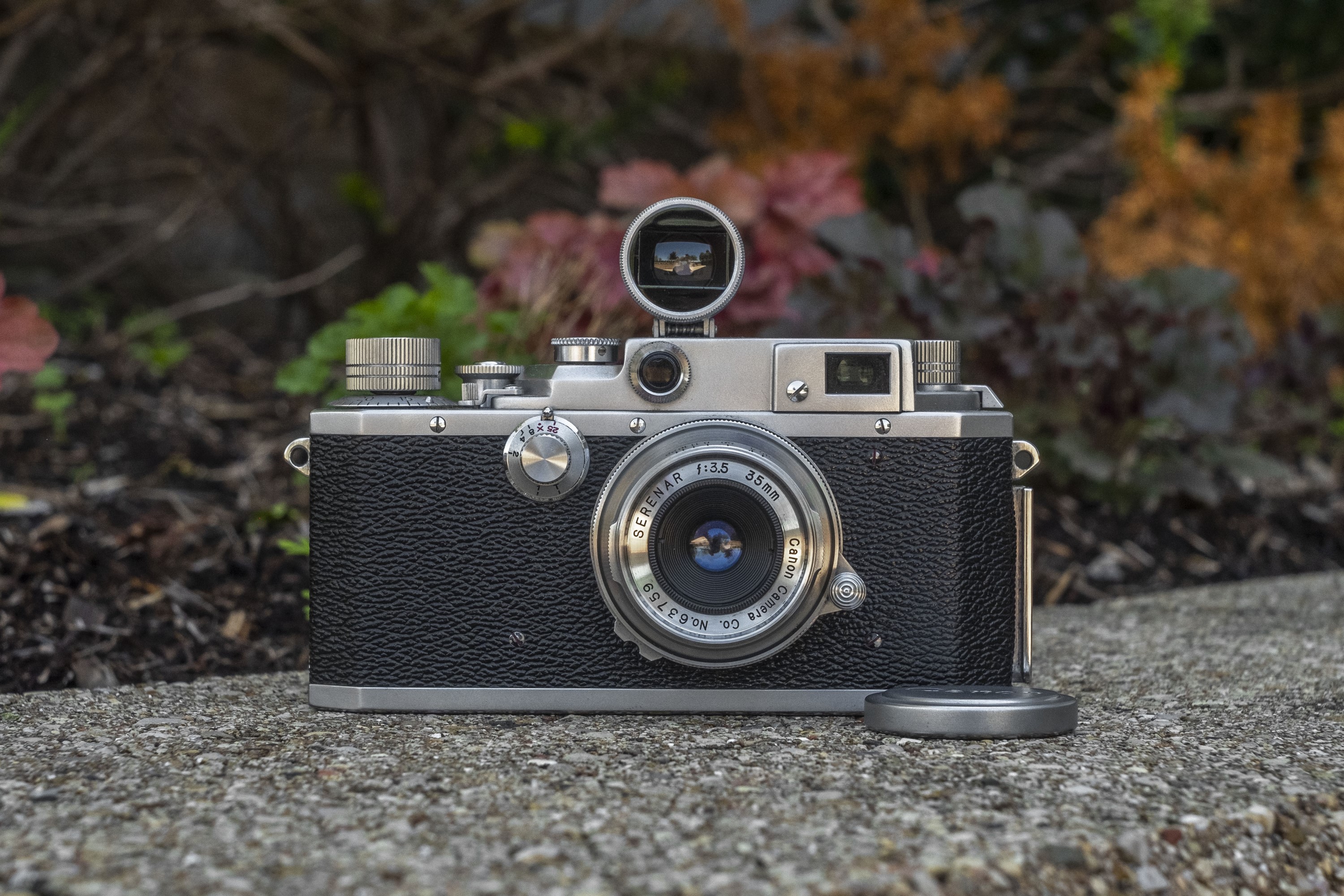
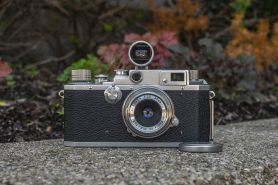
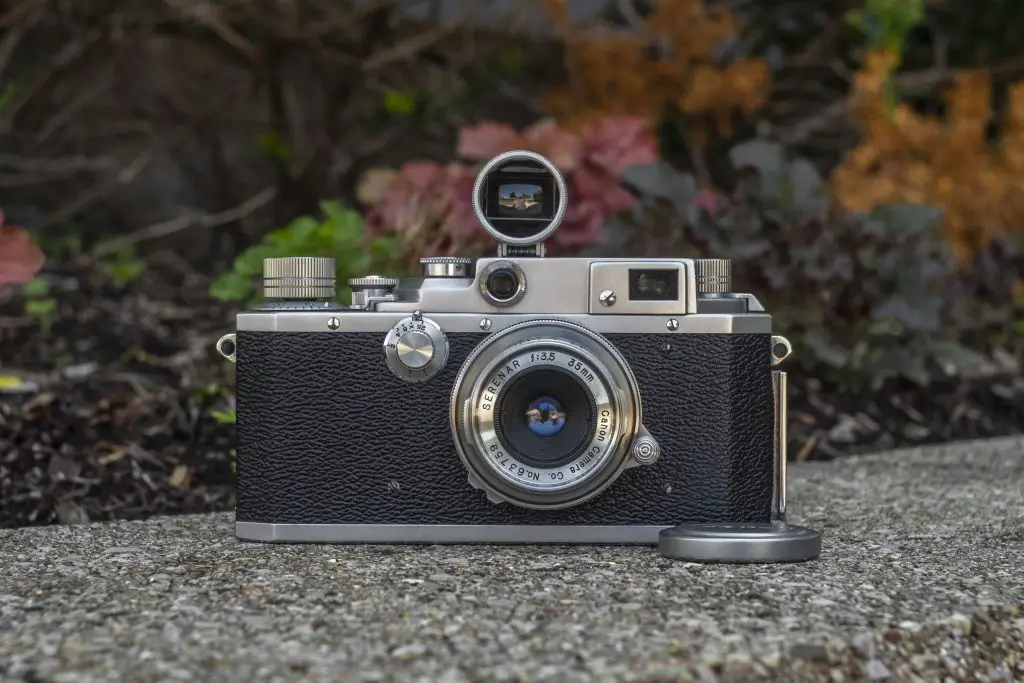













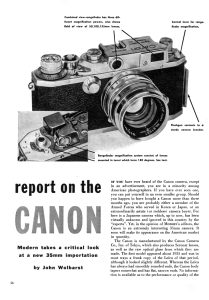
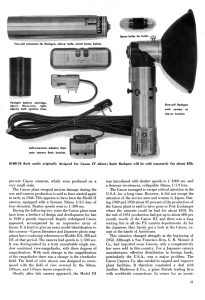

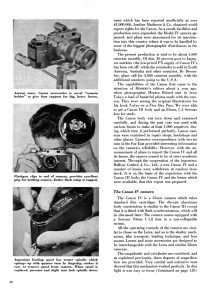
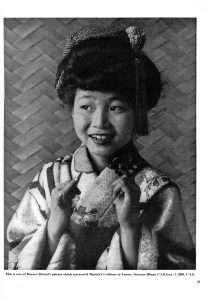
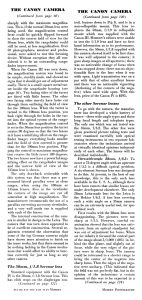
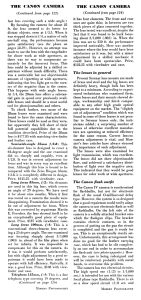

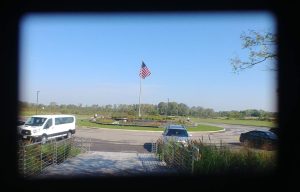
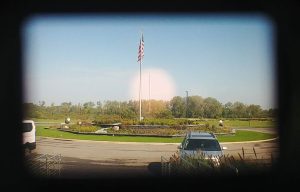
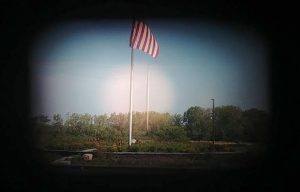
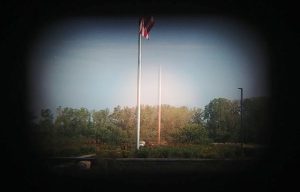



























Great review. I think the only Canon RFs which grab my attention are this, and Canon P. Probably the most technically advanced model is Canon 7, but somehow I don’t like its look :p
The Canon P would still get my vote for my favorite Canon rangefinder, but only by a very small amount. Where the P is a more modern camera with a larger and easier to use viewfinder, the IV Sb is more compact, and a classic design that is so much fun to use.
I actually do have a Canon 7 “in the queue” that I’ll likely get to someday, so maybe I’ll change my tune after giving that one a thorough review.
Canon was caught flat-footed by the Leica M3 in 1954. Nikon had already been working on a replacement for the Nikon S, so was able to get the S2 in stores by the end of that year. Canon had nothing ready and it took until February 1956 to announce the Canon VT. Unfortunately, the ads promised that the new model was “coming next month”—which it wasn’t. Supplies were low until that summer and Canon sales took a major hit during that period. The biggest drawback of the IV-S2 was the flash hot rail on the side of the camera. Only Canon flash guns would work seamlessly, and they had to be mounted on the hot rail. This was a serious problem for pros who were used to remote and extended flash. I am not sure about your statement that the Canon IV was the first to offer X sync, since Nikon Ss and Contaxes offered X sync when the speed was set low enough (and in the case of the Contax the proper sync connecting cord was used). Nice review and I would agree that the Canon IV was the best of the original “small” Canons.
I agree, Canon’s flash rail was not ideal compared to other solutions. I got the comment about being the first with X-sync from Peter Dechert’s book. Perhaps I misinterpreted what he said. Perhaps he meant first 35mm with a non-leaf shutter as I know leaf shutters are easy to sync. I’ll have to take a second look.
I totally agree with you. I have owned a Barnack and an IV SB2. On my last day in Japan I picked up the Canon IV SB2 for about $40 and it is the only camera I have had cla’d, I sold the Leica to pay for it. Thar brought the overall cost of the SB2 up a fair amount. I love it and much prefer to the Leica III. The viewfinder is brighter and easier to use, plus the magnifier. I need to take it out again soon.
The Sb2 is even better than the Sb! Although the differences are negligible, you had the perfect camera for many decades to come with that CLA. I might consider doing the same with mine, if it didn’t already work perfectly! I also have a VT Deluxe and Canon 7 that one day I’ll review too.
Another great article. No denying the superb build of these early Canons. During this time several Japanese manufacturers were trying to exceed German quality
Thanks for the comments, Kurt. If things go well, I’ll have a couple other Japanese Leica copies to review someday as well! 🙂
Great review of the IVSB Mike, I would have to agree with all your conclusions, I agree Haze is a concern with many of the older Canon optic’s and seems to be prevalent on many coming out of Japan these days. No idea of the cause maybe environment or is it in the construction materials used as those years ago. A nice addition to a IVSB is Canons Rapid Winder, it works rather well IMHO. Looking forward to reading more of your reviews. Regards Richard
My thanks for the article on your Canon IV. You’re right – there sure isn’t a whole lot out there about them. Last summer I bought a couple of Canon rangefinders, a IVs and a 7 and a few lenses and am enjoying them immensely. I had a Leica IIIf and M3 back in the 80s and it is nice to return to that way of working, but with the Canons instead.
Thanks for the compliments Bruce. I very much love the IVSb and actually have a Canon 7 that’s in perfect working condition that I’ll eventually test. It’s a fine camera too, but there’s just something special about those earlier cameras!
Great article, and it brings back many memories. Before I switched to digital ten years ago (making me a late convert) my principal system was Leica/Canon LTM, along with lenses of both makes. One of those was similar to the IVsb, a IIs (IIRC) that became pretty much my go-to rig with the 35m Serenar and accessory viewfinder mounted. I was doing a lot of SAR work in those days, so that Canon had an adventurous life. It was attached to me when I hung out out of many helicopters and rappelled over countless cliffs. Photography under such circumstances is strictly a point and shoot proposition, done either very rapidly or not at all. I would take a meter reading at the outset, set the shutter speed high enough to compensate for motion, adjust the lens for hyperfocal distance and take my photographs as circumstances allowed. That camera never failed me in that pursuit. Years later, long past my SAR assignments, the shutter started sticking. I took it to a local camera repair tech, and he put me back in business for around twenty dollars. He said that aside from needing a lube, the shutter system was perfect. I continued to use that Canon (and several additional Canon and Leica bodies) until I departed for digital. It ran when parked.
During the early-mid 80’s I used to go into a camera shop on Grant Ave in San Francisco near Chinatown. It was run by two guys from the middle east (don’t know where). I only ever dealt with one of them, because he pulled weekends while the other one ran it during the week. The one with whom I dealt told me one day that they had a brand new, in the box, Canon IVsb2, that the partner might be willing to let go. He did not have the key to the cabinet where this camera was, but said he would get in from his counterpart when they were both there during the week. Naturally I was very interested. I returned the next Saturday, although we lived some distance away, because my wife fortunately had a high school reunion. The camera was just as described; brand new, in the box, with the 50mm f1.8 lens attached. It looked to me like a piece of jewelry it was so perfect. Looking at that camera just as it came from the factory, the ultimate bottom load Canon iteration, the level of quality is obvious. Needless to say I bought it, at what I consider (then and now) a very fair price. But it was too beautiful and pristine to be used, would only be new once, and I had several others on hand, so I never used it. Fast forward to today, and I really do enjoy my digital cameras. Even more so I love the photographs I get, which is the purpose behind all this, so there is no going back for me. The photographic objective for me is the photograph I print and put on the wall. But when I take that IVsb2 out and look at it, I see a level of craftsmanship and pride in product that makes it obvious how the Japanese so quickly photographically won the west following World War II.
What a fantastic story Roger! To think that you were there falling from the sky with a half century old camera and it was still working as perfectly as the day it was made. To be able to get it serviced for $20 is a steal!
I also agree, keeping that minty IVSb2 on a shelf is a good spot for it! I would be terrified to take something like that out shooting. That said, if you ever make the decision to get rid of either of your Canons, hopefully you’ll keep me in mind! 🙂
Dear Mr Eckman, I’ve just got myself a lovely Canon IV SB but I am unable to find any kind of cable release or anything else that might trigger the shutter when I want to use slow speeds. If you have any ideas I would be very grateful.
John, the Canon IVSb is not threaded for a shutter release cable. If you want to make exposures longer than 1 second, you have both B and T modes. In B mode, the shutter will remain open for as long as you maintain pressure on the shutter release. In T mode, a single press of the shutter release will open the shutter and it will remain open for as long as you leave the camera in T mode. To close the shutter, you need to rotate the slow shutter speed dial on the front of the camera, away from the T mark and the shutter will close.
My film gear is buried in my safe, so I am not 100% certain on what follows, but pretty close. My recollection is that the bottom loader Canons would accommodate a cable release by unthreading the collar surrounding the shutter release button, removing it, and threading on the cable release. I have two very old books on these series Canons, ‘The Canon Guide to 35m Photography’ (Kenneth Tydings, 1935) and ‘Canon Photography’ (Jacob Deschin, 1967). Both of these books illustrate and/or discuss the use of a cable release. They would also accommodate a separate self-timer in a similar manner. I have each of these accessories. But I have not used any film gear in the ten+ years since I went to digital. I no longer recall if these accessories fit my bottom loader Canons, my similar Leicas, or both. I have a quantity of both since I used them interchangeably as a single system (which they are even though unrelated elements), so while the lenses/bodies and some accessories may be interchangeable (such as the Visoflex reflex housing), it does not necessarily follow that all accessories are. I hope this will help Mr. Middleton. Locating such accessories may prove somewhat elusive though.
Mea culpa on the near duplicate post. I was finishing the first one, inadvertently hit a wrong key. I made several attempts to retrieve it, but could not locate it, even by going out completely and then going back on the website. Then, when I posted the second attempt, there was the first. Pilot error.
Hi, thank you for your great work!
I purchased an IV-SB in mint condition from a seller on eBay and everything works well, except of the T mode.
After winding the camera, I set the high speed dial to 25-1 and the low speed dial to T.
After pressing the release button, the shutter should stay open until the low speed dial is set to 1, according to the manual.
However in my case, the T setting seems to trigger the 1 second speed. After this, the shutter closes automatically.
The B mode works as expected so this is no big deal. However, the camera was sold as fully functional and I would like to exclude any wrong operation on my side.
Does you T mode work as described above (according to the manula) ?
Thanks & best wishes!
Thomas, I just checked my IV Sb and can confirm the T mode works exactly how the manual describes. Setting the fast speed knob to 25-1 and the slow speed knob to T, when I press the shutter release, the shutter opens and stays open until I turn the slow speed dial back to 1. It does not trigger the 1 second speed like yours does. That said, that is a pretty minor issue. If the camera is otherwise in good shape and the price you paid for it is reasonable, I probably wouldn’t make a big deal of it. On the other hand, if you paid an appropriately high price for a perfect working camera, you should have a perfect working camera. Good luck!
Wonderful thread, thanks! I have a rare contempory to the IV Sb, a 11F2, only about 2500 made apparently. Differences are a 500 top speed, no X flash synchronisation but it does have a flash bar. It has the later “half” shutter speeds 500-250-125-60-(front Dial) 30-15-8-4-2-1-T as on the IV Sb2. It also marked E-P, which is late in the day for that marking. It’s in wonderful condition although it has no leather case – these are pretty scarce. I use it with a Serenar f3.5 /50 from my other Canon S II which is “at least as good as an Elmar”.
35 mm film is pretty scarce here but I did get several rolls of (VERY old) Gevaert film which is Ok but has a Brown tinge, maybe the film age.